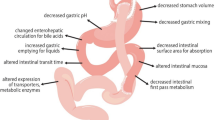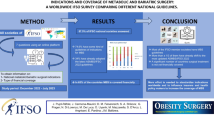Abstract
While bariatric procedures continued to evolve and develop since the 1950s, their classification has not matched this evolution. The procedures are commonly classified into restrictive, malabsorptive, or combined. In this day and age, we recognize different mechanisms of action of the bariatric procedures. This article aims to review and update the old classifications based on our current understanding of the hormonal aspects of the various bariatric procedures and the role of gut hormones in weight loss and treatment of the associated metabolic comorbidities. The article suggests the need for a new classification of the bariatric procedures, based on the mechanism of action, involving the hormonal aspects of the procedure.
Similar content being viewed by others
References
Kremen A, Linner J, Nelson C. An experimental evaluation of the nutritional importance of proximal and distal small intestine. Ann Surg. 1954;140:439–48.
Griffen Jr W, Bivins B, Bell R. The decline and fall of jejunoileal bypass. Surg Gynecol Obstet. 1983;157:301–8.
Payne J, DeWind L. Surgical treatment of obesity. Am J Surg. 1969;118:141–7.
Rucker R, Chan E, Horstmann J, et al. Searching for the best weight reduction operation. Surgery. 1984;96:624–31.
Payne J, Dewind L, Commons R. Metabolic observations in patients with jejunocolic shunts. Am J Surg. 1963;106:273–89.
Scopinaro N, Gianetta E, Adami G, et al. Biliopancreatic diversion for obesity at eighteen years. Surgery. 1996;119:261–8.
Marceau P, Biron S, Bourque R, et al. Biliopancreatic diversion with a new type of gastrectomy. Obes Surg. 1993;3:29–35.
Kuzmak L, Yap I, McGuire L, et al. Surgery for morbid obesity using an inflatable gastric band. AORN J. 1990;51:1307–24.
Kojima M, Hosoda H, Date Y, et al. Ghrelin is a growth-hormone-releasing acylated peptide from stomach. Nature. 1999;402:656–60.
Yang J, Zhao T, Goldstein J, et al. Inhibition of ghrelin O-acyltransferase (GOAT) by octanoylated pentapeptides. Proc Natl Acad Sci U S A. 2008;105:10750–5.
De Vriese C, Gregoire F, Lema-Kisoka R, et al. Ghrelin degradation by serum and tissue homogenates: identification of the cleavage sites. Endocrinology. 2004;145:4997–5005.
Cummings D, Purnell J, Frayo R, et al. A preprandial rise in plasma ghrelin levels suggests a role in meal initiation in humans. Diabetes. 2001;50:1714–9.
Drazen D, Vahl T, D’Alessio D, et al. Effects of a fixed meal pattern on ghrelin secretion: evidence for a learned response independent of nutrient status. Endocrinology. 2006;147:23–30.
Taheri S, Lin L, Austin D, et al. Short sleep duration is associated with reduced leptin, elevated ghrelin, and increased body mass index. PLoS Med. 2004;1:e62.
Wren A, Seal L, Cohen M, et al. Ghrelin enhances appetite and increases food intake in humans. J Clin Endocrinol Metab. 2001;86:5992.
Nagaya N, Itoh T, Murakami S, et al. Treatment of cachexia with ghrelin in patients with COPD. Chest. 2005;128:1187–93.
Cummings D, Weigle D, Frayo R, et al. Plasma ghrelin levels after diet-induced weight loss or gastric bypass surgery. N Engl J Med. 2002;346:1623–30.
Halem H, Taylor J, Dong J, et al. Novel analogs of ghrelin: physiological and clinical implications. Eur J Endocrinol. 2004;151:S71–5.
Kobelt P, Helmling S, Stengel A, et al. Anti-ghrelin Spiegelmer NOX-B11 inhibits neurostimulatory and orexigenic effects of peripheral ghrelin in rats. Gut. 2006;55:788–92.
Zorrilla E, Iwasaki S, Moss J, et al. Vaccination against weight gain. Proc Natl Acad Sci U S A. 2006;103:13226–31.
Cytos Biotechnology. Phase I/IIa clinical trial with obese individuals shows no effect of CYT009-GhrQb on weight loss. Cytos Biotechnology. Press release November 7, 2006. Retrieved 2 June 2009.
Tan T, Vanderpump M, Khoo B, et al. Somatostatin infusion lowers plasma ghrelin without reducing appetite in adults with Prader–Willi syndrome. J Clin Endocrinol Metab. 2004;89:4162–5.
Adrian T, Bloom S, Bryant M, et al. Distribution and release of human pancreatic polypeptide. Gut. 1976;17:940–4.
Lieverse R, Masclee A, Jansen J, et al. Plasma cholecystokinin and pancreatic polypeptide secretion in response to bombesin, meal ingestion andmodified sham feeding in lean and obese persons. Int J Obes Relat Metab Disord. 1994;18:123–7.
Silvestre R, Rodriguez-Gallardo J, Jodka C, et al. Selective amylin inhibition of the glucagon response to arginine is extrinsic to the pancreas. Am J Physiol Endocrinol Metab. 2001;280:E443–9.
Rushing P, Hagan M, Seeley R, et al. Amylin: a novel action in the brain to reduce body weight. Endocrinology. 2000;141:850–3.
Westermark P, Engstrom U, Johnson K, et al. Islet amyloid polypeptide: pinpointing amino acid residues linked to amyloid fibril formation. Proc Natl Acad Sci U S A. 1990;87:5036–40.
Paik K, Jin D, Lee K, et al. Peptide YY, cholecystokinin, insulin and ghrelin response to meal did not change, but mean serum levels of insulin is reduced in children with Prader–Willi syndrome. J Korean Med Sci. 2007;22:436–41.
Batterham R, Heffron H, Kapoor S, et al. Critical role for peptide YY in protein-mediated satiation and body-weight regulation. Cell Metab. 2006;4:223–33.
Beckh K, Mönnikes H, Loos S, et al. Low hepatic clearance of peptide YY in the perfused rat liver. Regul Pept. 1992;37:205–12.
Adrian T, Ferri G, Bacarese-Hamilton A, et al. Human distribution and release of a putative new gut hormone, peptide YY. Gastroenterology. 1985;89:1070–7.
MDRNA. (2008). MDRNA announces phase 2 trial of PYY(3–36) does not meet weight loss endpoint. MDRNA. Press release 31 July 2008.
Pedrazzini T. Importance of NPY Y1 receptor-mediated pathways: assessment using NPY Y1 receptor knockouts. Neuropeptides. 2004;38:267–75.
Bataille D, Gespach C, Tatemoto K, et al. Bioactive enteroglucagon (oxyntomodulin): present knowledge on its chemical structure and its biological activities. Peptides. 1981;2 Suppl 2:41–4.
Baggio L, Huang Q, Brown T, et al. Oxyntomodulin and glucagon-like peptide-1 differentially regulate murine food intake and energy expenditure. Gastroenterology. 2004;127:546–58.
Orskov C, Wettergren A, Holst J. Secretion of the incretin hormones glucagon-like peptide-1 and gastric inhibitory polypeptide correlates with insulin secretion in normal man throughout the day. Scand J Gastroenterol. 1996;31:665–70.
Mentlein R, Gallwitz B, Schmidt W. Dipeptidyl-peptidase IV hydrolyses gastric inhibitory polypeptide, glucagon-like peptide-1(7–36)amide, peptide histidine methionine and is responsible for their degradation in human serum. Eur J Biochem. 1993;214:829–35.
Marre M, Shaw J, Brandle M, et al. Liraglutide, a once-daily human GLP-1 analogue, added to a sulphonylurea over 26 weeks produces greater improvements in glycaemic and weight control compared with adding rosiglitazone or placebo in subjects with type 2 diabetes (LEAD-1 SU). Diabet Med. 2009;26:268–78.
Pournaras D, Osborne A, Hawkins S, et al. The gut hormone response following Roux-en-Y gastric bypass: cross-sectional and prospective study. Obes Surg. 2010;20:56–60.
Kotidis EV, Koliakos G, Papavramidis T, et al. The effect of biliopancreatic diversion with pylorus-preserving sleeve gastrectomy and duodenal switch on fasting serum ghrelin, leptin and adiponectin levels: is there a hormonal contribution to the weight-reducing effect of this procedure? Obes Surg. 2006;16:554–9.
Beckman L, Beckman T, Earthman C. Changes in gastrointestinal hormones and leptin after Roux-en-Y gastric bypass procedure: a review. J Am Diet Assoc. 2010;110:571–84.
Bohdjalian A, Langer F, Shakeri-Leidenmühler. Sleeve gastrectomy as sole and definitive bariatric procedure: 5-year results for weight loss and ghrelin. Obes Surg. 2010;20:535–40.
Tzovaras G, Papamargaritis D, Sioka E, et al. Symptoms suggestive of dumping syndrome after provocation in patients after laparoscopic sleeve gastrectomy. Obes Surg. 2011;22(1):23–8.
Lee WJ, Chen CY, Chong K, et al. Changes in postprandial gut hormones after metabolic surgery: a comparison of gastric bypass and sleeve gastrectomy. Surg Obes Relat Dis. 2011;7(6):683–90.
Financial Disclosure
The author has no financial interest to disclose.
Author information
Authors and Affiliations
Corresponding author
Rights and permissions
About this article
Cite this article
Akkary, E. Bariatric Surgery Evolution from the Malabsorptive to the Hormonal Era. OBES SURG 22, 827–831 (2012). https://doi.org/10.1007/s11695-012-0623-2
Published:
Issue Date:
DOI: https://doi.org/10.1007/s11695-012-0623-2




